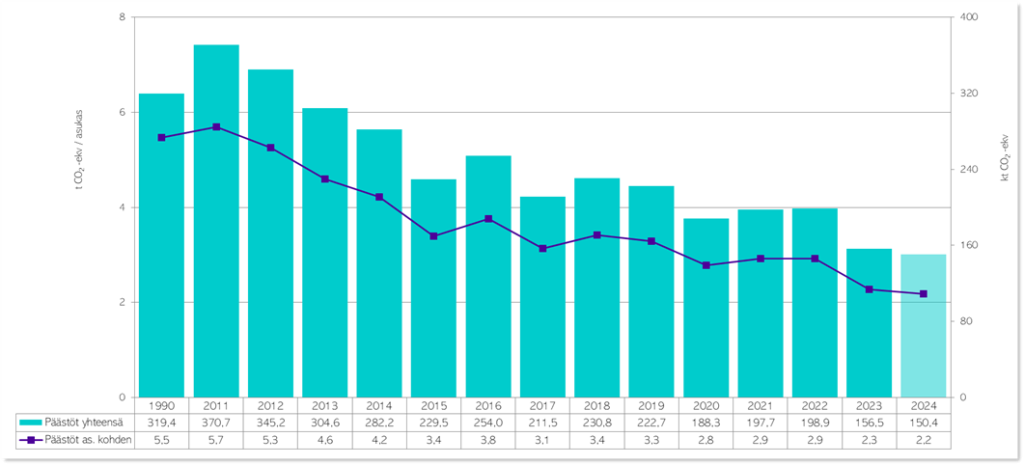
Article categories: Archive News
The carbon footprint of Vaasa and its residents calculated
Published: 16.5.2025
The 2024 carbon footprint from consumption by Vaasa residents has been calculated as part of the Kulma project. The Kulma project was carried out for the third time this year, involving Vaasa and 21 other municipalities.
Vaasa has once again participated in assessing the greenhouse gas emissions – or carbon footprint – resulting from its residents’ consumption. Consumption-based carbon footprint refers to the emissions generated by energy use, construction, transport, food, and the purchase of goods and services.
According to the Kulma report, Vaasa’s consumption-based greenhouse gas emissions totalled 524.4 kilotonnes of carbon dioxide equivalent (CO₂e) in 2024. Compared to the other municipalities in the Kulma project, Vaasa had the sixth lowest level of consumption-based emissions.
The largest share of emissions came from goods and services (30%), followed by food (28%), energy consumption (20%), and mobility (19%). Emissions from construction were the lowest, accounting for just 3%.
– The fact that goods and services form the largest emissions category is partly explained by our reliance on commodities sourced globally. In Vaasa, public-sector procurement and services account for approximately 8% of this total, says Johanna Punkari, Energy and Climate Specialist for the City of Vaasa.
In the Kulma project, municipal greenhouse gas emissions are measured using both a consumption-based and a regional carbon accounting model. The aim of consumption-based carbon accounting is to include all emissions resulting from residents’ and the public sector’s consumption, regardless of where the goods or services were produced.
Carbon neutrality is monitored through regional carbon accounting
Municipalities have a strong opportunity to influence the reduction of greenhouse gas emissions from consumption. Extensive data and insights into the greenhouse gas emissions generated by the city and its residents support the planning and targeting of climate actions, as well as the assessment of their impact.
– Vaasa’s strategic carbon neutrality target is monitored through production-based, or regional, carbon accounting. This reflects the emissions actually produced in the area, but does not account for the emissions from goods and services produced elsewhere that we purchase, explains Punkari.
Vaasa’s regional, or production-based, carbon accounting is monitored through a CO₂ report. The CO₂ report is based on the results of regional carbon accounting, including greenhouse gas emissions generated within the municipality, as well as those from energy and waste management, agriculture, and production.
– Based on the CO₂ report, we can see that Vaasa’s emissions have steadily decreased in recent years. Using the regional carbon accounting model, Vaasa’s emissions have decreased by 53 percent compared to 1990, says Punkari.

– A fairer way to track emissions would be a consumption-based approach, which, in addition to the region’s production-based emissions, also accounts for goods and services purchased by residents and the public sector, as well as construction within the area and the global emissions generated by these activities. However, this form of carbon accounting is based on certain assumptions and is therefore not as accurate or justified, estimates Punkari.
Achieving carbon neutrality through cooperation
The City of Vaasa’s strategic goal is to become carbon neutral in the 2020s. Carbon neutrality means significantly reducing greenhouse gas emissions in the urban area and offsetting the remaining emissions.
This year, the city is working on a climate roadmap, which will define Vaasa’s steps towards carbon neutrality in more detail. The aim is also to acquire a climate change monitoring tool and to calculate the impact of the actions taken on the city’s emissions trajectory. With the climate roadmap, actions and their impacts can also be made visible to the city’s residents. Moreover, the tool will also support decision-making.
In addition to the city’s actions, achieving the carbon neutrality target requires collaboration from businesses, residents, and other stakeholders. The Vaasa Climate Commitment is an initiative that strengthens collaboration between companies, organisations, and the city to achieve its climate targets.
The results of the study conducted within the Kulma project further confirm that the everyday choices of households and individuals play a crucial role in mitigating climate change. For example, doubling the lifespan of a single piece of clothing or household textile can reduce the associated greenhouse gas emissions by up to 50%. As more and more people make sustainable choices in their daily lives, the collective impact becomes increasingly significant.
The Kulma project was carried out by Sitowise Oy in collaboration with the Natural Resources Institute Finland (Luke).
For more information about the project and its results, please visit: www.sitowise.com (in Finnish)
